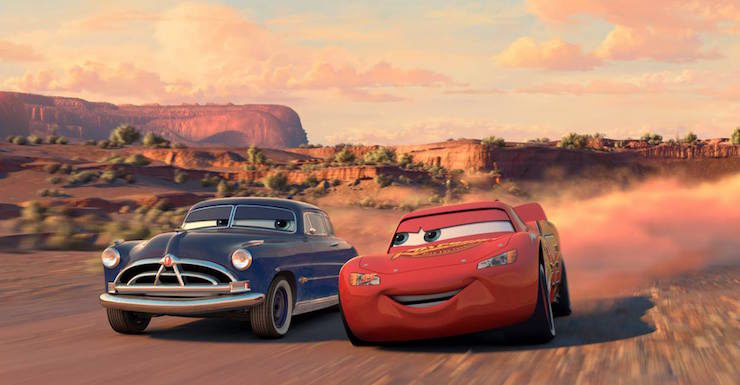Disney executives watched the success of the Pixar films with mingled joy and alarm. On the one hand, the Pixar films—particularly Finding Nemo and the two Toy Story films—were bringing quite a bit of money into their coffers, both in box office receipts and ancillary merchandise revenue. On the other hand—well, after the late 1990s, most of the Disney produced animated films were losing money, and only Lilo & Stitch was bringing in anything close to the ancillary revenue generated through sales of little Woodys, Buzz Lightyears, Monsters and Nemos.
Pixar arguably was overtaking Disney on what had been their exclusive, lucrative domain. (Arguably, since other studios had also produced financially successful full length animated movies, and the Disney issues had more to do with the quality of their films than with their rivals.) And, far more alarmingly, relationships between the two companies were slowly but surely disintegrating, even as Pixar animators showed Disney executives concept art of talking cars.
Wall Street executives and journalists alike were later to blame this disintegration on the crashing personalities and egos of Disney CEO Michael Eisner and Pixar CEO Steve Jobs. But their egos were only part of the problem. The two had very real contractual fights as well. Eisner, for instance, had insisted on treating Toy Story 2 and the proposed Toy Story 3 as mere sequels to Toy Story, instead of two separate films that would count towards the five films that Pixar had promised Disney—forcing Pixar to produce two more films.

More alarmingly, from the point of view of Steve Jobs, Eisner had attacked Jobs’ other company, Apple, during testimony in front of the United States Senate, blaming Apple for encouraging internet piracy—which to Eisner, was the same as attacking Disney and ABC revenue. Jobs was outraged, and after allegedly yelling at a number of Disney executives who had not testified in front of the Senate, he much less allegedly reached out to Roy Disney, announcing that once Pixar had fulfilled its contract—with either six (five films plus Toy Story 2 in Pixar’s version of the contract) or seven (five films plus Toy Story 2 and Toy Story 3 in Disney’s version) or eight (all of those plus a sequel to Monsters, Inc., also in Disney’s version) the company would completely sever its ties with Disney. Roy Disney, who had his own issues with Eisner, began making moves to force Eisner out.
In 2003, Jobs took things still further. After meeting with various Disney rivals, Jobs offered Eisner a revised deal where Disney could still use Pixar’s characters in its theme parks and on its cruise ships—an ongoing lucrative arrangement—but would no longer share ownership in Pixar films. Instead, Disney would receive a distribution fee. Eisner noted that Disney had the rights to make sequels to the existing Pixar films, and had Roy Disney forced out from the Disney board. Steve Jobs responded by making very mean (if accurate) comments about the various direct-to-video Disney sequels.
By early 2004, Steve Jobs announced that he was ending negotiations with Disney, and that once Pixar had delivered the two pending films, he would stop working with Disney until and unless Eisner left the company. Pixar delivered The Incredibles in November 2004. Only one more film, and then finally the Pixar/Disney relationship would be over, finito, ended, completely over. Jobs contacted various Hollywood distributors. Disney executives not named Eisner tried to keep polite cover faces. Even the announcement, in early 2005, that Eisner would step down before his contract expired did not calm Jobs: he announced that Pixar would be delivering its last film—a small thing about talking cars—and that would be it. This did not create a smooth relationship between Pixar artists and Disney executives, and added to the usual tensions of film development.

Much worse was to come, when Cars co-director Joe Ranft was unexpectedly killed in a car accident midway through production, at the too young age of 45. It was a major loss for the company: Ranft had worked on all of Pixar’s films, as a concept artist, storyboard artist, story writer, director and/or voice actor, while continuing to work with Tim Burton’s various stop-motion films. It also put Cars back into the distracted hands of John Lasseter, busy with the tense Disney/Pixar negotiations and concerns about what Disney would do to his beloved Toy Story and Monsters, Inc. characters if the studio exercised their right to make sequels, and less concerned with talking cars.
All of this background drama, and Lasseter’s inability to focus on this film as much as he had on previous Pixar efforts, probably helps explains why Cars is regarded by most fans as one of the weakest of the earlier Pixar films, with a select few naming A Bug’s Life instead. Pixar had, of course, produced films under equally stressful conditions, with Toy Story essentially a Hail Mary pass for the studio, and Toy Story 2 reaching the point of giving animators repetitive stress injuries and making them wonder what that odd thing called “sleep” was. And in some ways, Pixar’s position had never been stronger. At the same time, these sorts of contractual disputes and background drama were more distractions than motivators—and Pixar definitely needed motivators.
Especially when trying to create a convincing world populated by sentient cars.
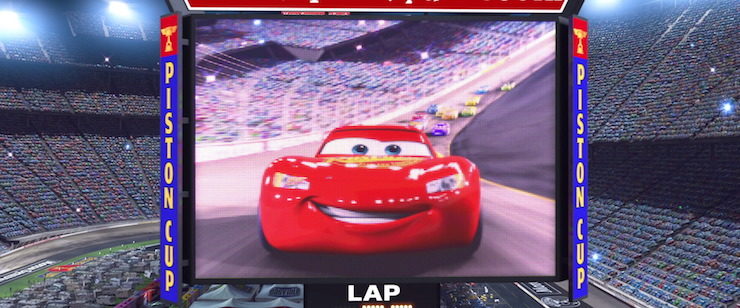
However distracted, John Lasseter did come to Cars with a lifelong love of cars and driving. Pixar’s success had allowed him to slowly build a collection of classic cars, and as production started, he felt he knew cars. But that did not exactly completely bridge the gap between “car knowledge” and “creating a world inhabited by sentient cars.” For inspiration, Lasseter and other story artists, including Joe Ranft, drove along Route 66 and visited various car shows and auto body shops, learning about things like car paint. Most of the characters were modeled on various classic cars, updated to include eyes and mouths.
Left out was exactly why these cars had gained independence and sentience, not to mention why they had then chosen to imitate American culture. To be fair, no one at Pixar had bothered to explain how, exactly, toys had become sentient, or why human-fearing monsters had built a world that mirrored the human world so closely.
Though at least some people at Pixar did put a little bit of thought into this. Eventually. And by eventually, I mean years later—2017, to be exact— when Jay Ward, the Creative Director of the Cars franchise, told Matt Singer of ScreenCrush that the cars had simply decided that they didn’t actually need humans, and got rid of them—but not before taking on the personality of the last person who drove them. I’m assuming that the personalities of former rental cars are somewhat fragile and easily disrupted, though no one at Pixar has confirmed this.
For now, we’ll just have to take it for granted that the cars of the world all leapt forward as one and destroyed every human on the planet, along with cows (replaced, apparently, by tractors), bugs (replaced, apparently, by flying Volkswagen Bugs), and, well, apparently all other organic life forms, in a process so smooth and fast that it didn’t even disturb U.S. highway systems.
I recommend caution when you next enter a motorized vehicle.
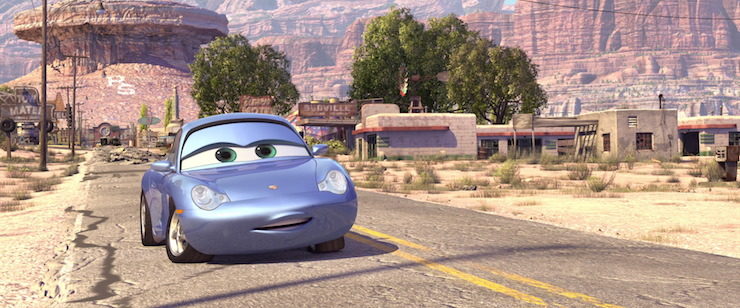
Anyway. Lasseter didn’t just want to create a new world: he also wanted Cars to follow the now-classic Pixar tradition of upping the computer technology with each and every film. In this case, he decided that Cars would include ray tracing—a rendering process that simulated the movement of light, which in non-technical terms meant that the cars would reflect the light properly. The process required another classic Pixar tradition: updating the computer technology. Pixar’s new computers, Lasseter excitedly explained, were about 1000 times faster than the computers used in Toy Story. Despite that speed, it still took Pixar about 17 hours to render each frame of Cars. The results were undoubtedly worth it—some of the shots of the American Southwest are breathtakingly beautiful—but the time consuming process meant that once again, Pixar artists found themselves scrambling to meet Disney’s deadlines, and spending less time on story development and jokes.
Which meant that throughout development, Cars struggled with background tensions, rendering issues, and world development issues. To all this, the film added another Pixar first: a protagonist who is not, initially, at all easy to like. Oh, Lightning McQueen can be charming enough, and a number of cars are more than willing to flash their headlights at him. But both in and out of the spotlight, he quarrels with his road crew and is obnoxious to his fans, his sponsors, and his main driver, Mack. Not surprisingly, he doesn’t have any friends, unless we count his agent, and we probably can’t since we never even see the agent and since the agent confesses that he didn’t even watch Lightning’s big race.
This is all, of course, a setup for that great movie cliché: Lonely, obnoxious protagonist Learns the True Meaning of Friendship and What’s Important in Life. And it helps that for all his bravado and arrogance and insistence that he’s too good for his sponsors, Lightning McQueen is self-aware enough to know that he’s lonely, and needs friends. Indeed, a good part of his quest for new sponsors seems to be the hope that with new sponsors will come new friends. And despite his immediate attempt to ditch out of his well-deserved punishment for wrecking the road in a small, economically failed town, and his tendency to hit on any attractive car within honking distance, he quickly becomes almost kind to the not overly bright and shiny Mater, a tow truck who has definitely known better days.

The movie contains several things that we probably don’t want to consider too closely, like, isn’t rolling into the container part of a sentient truck just a little like rolling into the body of a sentient being? I know trucks in real life change their containers all the time, but still, this is fairly icky—cool though the idea of constantly body-changing trucks is. (I may have watched a little too many Transformers cartoons as a kid.) And several things that just make no sense whatsoever—like, why are these tractors all resting out in the fields, and what exactly are they doing during the day? (Apart, of course, from rather conveniently resting around for a cow tipping joke.) If they’re part of the food/energy production system for cars, shouldn’t they be over in Texas trying to find more oil?
In some ways, though, perhaps the worst part of the film are not the questions of “how does this work?” but rather all of the sly in jokes and references. This was nothing new for Pixar, of course, who had practically started their studio with in jokes about various toys, and continued to add different references to all of their films. And to a certain extent, the movie’s focus on car racing almost demands a few in jokes, like, say, having Richard Petty voice a race car—a Plymouth with the number 43, naturally.
(Not at all coincidentally, while Cars was in production and during its release, Walt Disney World just happened to be hosting the Richard Petty Driving Experience; the attraction eventually closed down in 2015.)
And if Bob Costas was perhaps not the first name to come to mind with car racing, given his association with other sports, the use of a well-known color commentator during the car races was also probably inevitable. As were the “Lightyear” blimps and the tiny Volkswagen “bugs.” Also inevitable: Tom Cochrane’s “Life Is a Highway,” here covered by Rascal Flatts.
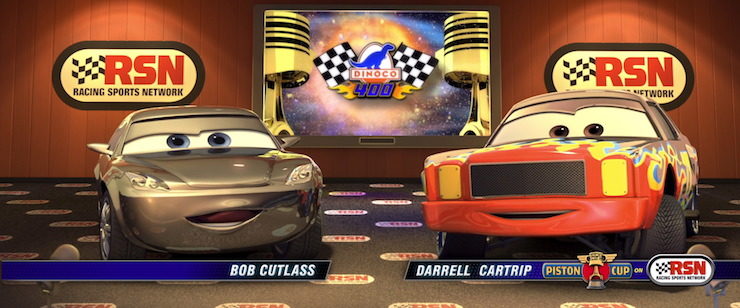
But after a time, all of this, including all of various cameos from various celebrity voice actors including Jay Leno, Michael Keaton, and the hosts of Car Talk, not to mention additional race car drivers (I sorta recognized Michael Schumacher and Mario Andretti; if IMDB is to be trusted, Dale Earnhardt, Jr. also voices one of the cars), becomes almost wearisome. Part of the problem is that the jokes feel expected, and also lack the sense of wonder that laced the similar in-jokes and references in Monsters, Inc. and the two Toy Story films. Indeed, a sense of wonder is arguably the greatest thing Cars lacks—gorgeous as some of the shots of the car-filled American Southwest are. It doesn’t help that the arguably best jokes are all saved for the end credits, particularly for a moment involving John Ratzenberger that if not quite worth the cost of admission, is certainly worth watching the credits for.
All this said, Cars remains watchable for any number of reasons: the gorgeous animation, the growing friendship between Lightning McQueen and Mater, and pretty much all of the racing, right down to the moment where Lightning McQueen realizes what’s really important about racing. If I’m kinda underwhelmed by the romance, I do enjoy the grudging respect and friendship between Lightning McQueen and Doc Hudson, not to mention the chance to hear the legendary Paul Newman—also an avid race car driver—in what was sadly to be his last film role. And let’s face it: it can be rather satisfying to watch the obnoxious, wealthy guy forced to personally fix things he’s broken, while risking his own career. Sure, we’ve seen it before, but that doesn’t remove the satisfaction here.
Small viewers had no complaints. Cars did well at the box office, bringing in $462.2 million in worldwide sales, well past any recent Disney animated release, if behind that year’s Ice Age: The Meltdown (which, I was surprised to learn, brought in $655.4 million. Seriously?). But the big thing, once again, was the ancillary marketing and the toys: kids loved Lightning McQueen, and they particularly loved the little Mattel versions of Lightning McQueen and other friends. The Disney theme parks added various Cars attractions, and if you pay very close attention to the end credits, they include assurances that Cars merchandise could be bought at Disney stores. That merchandise included the now-standard clothing, mugs, trading pins and more, along with household items for kids who were willing to give up Buzz Lightyear bedspreads for Lightning McQueen bedspreads.
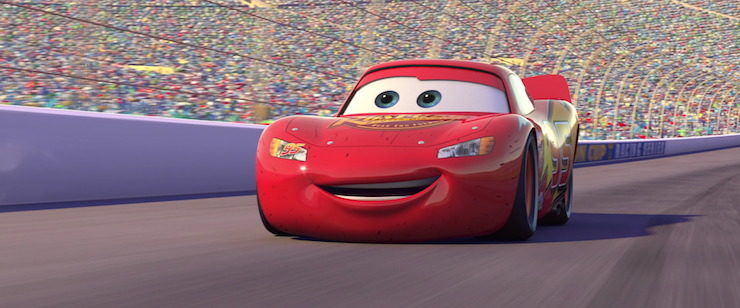
This all proved even more lucrative than the film, bringing in an estimated 1 billion in ancillary merchandise sales even before the sequel came out. This was, along with ancillary sales for Finding Nemo and the Toy Story films, one major reason behind Disney’s more recent decision to add a Pixar-focused area to their Hollywood Studios theme park, and later expand that, along with a Star Wars area—opening in 2018 and 2019, we’re assured.
But back in 2006, with the release of Cars, the Pixar/Disney relationship had come to an end. It was time, Steve Jobs felt and said loudly and publicly, for Pixar to release a film on its own—possibly with Disney distribution, or possibly not.
Ratatouille, coming up next month.
Mari Ness lives in central Florida.










